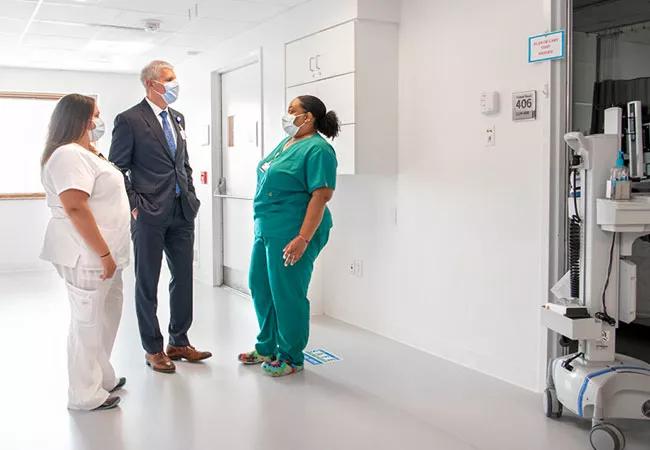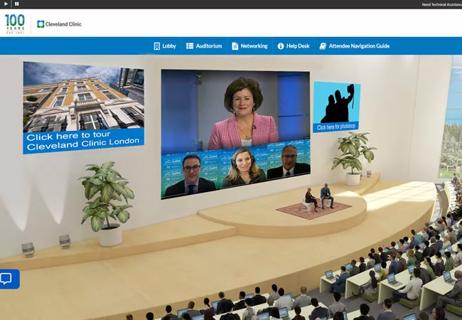Advertisement
Engagement should be a top priority for leaders

By K. Kelly Hancock, DNP, RN, NE-BC, FAAN, Chief Caregiver Officer, Cleveland Clinic Health System
Advertisement
Cleveland Clinic is a non-profit academic medical center. Advertising on our site helps support our mission. We do not endorse non-Cleveland Clinic products or services. Policy
In healthcare, having an engaged workforce makes all the difference in patient care and employee experience. It can be linked to higher patient satisfaction, increased patient safety and improved quality of care, as well as enhanced employee satisfaction and retention.
As workers continue to battle the challenges of the coronavirus pandemic, there’s never been a more crucial time for healthcare organizations to focus on employee engagement. Since the beginning of the pandemic, one in four healthcare workers has considered leaving their job, according to a recent survey by Mental Health America. Additionally, in a Gallup panel survey conducted from mid-March to mid-April 2020, 78% of healthcare workers reported that COVID-19 had a somewhat negative or very negative effect on their workplace.
So how do healthcare leaders boost employee engagement during a global pandemic? It won’t happen overnight, but by following these suggestions, leaders will see progress.
Listening to what employees tell you they need goes a long way. When workers feel like their feedback isn’t being heard, they can become disengaged and dissatisfied at work, which can lead to increased turnover and negative patient experiences.
Just a few months into the pandemic, our caregivers participated in an employee engagement pulse survey. The results from that survey offered tremendous insight into what caregivers felt they needed to get through the pandemic. It showed how COVID-19 was directly affecting caregivers and what would help them be the best versions of themselves amidst the challenges of the pandemic. It also helped our leaders confirm strategies that were or were not working.
Advertisement
The most engaged employees are those who are fully committed to your organization’s mission. Most people who’ve chosen a career in healthcare are already motivated by a strong desire to help others, but that doesn’t always translate to the organization. Without a strong employer connection – especially during a pandemic when every day presents new challenges – healthcare professionals can become disengaged and unmotivated.
By keeping your organization’s mission front and center in everyday communications, caregivers will feel more connected to the purpose of the organization. This will produce better work from employees, including higher quality care delivery, and help build caregiver resiliency. At Cleveland Clinic, we use an integrated model for caregiver engagement that aligns caregivers to our mission of caring for life, researching for health, and educating those who serve. We measure employees’ connections to our mission and share employees’ perceptions of our mission-driven workplace through our annual caregiver experience survey.
To ensure high levels of engagement, we need to remove barriers that may be standing in the way. Many healthcare organizations are facing staffing challenges, caregiver burnout and increased caregiver stress because of the pandemic. Outside of work, caregivers also continue to face stress, such as securing childcare, navigating virtual schooling, caring for sick relatives and more.
Supporting employees with solutions for these stressors can provide emotional relief and allow them to be more present and engaged at work. To help our caregivers and their families with challenges they may be experiencing in their personal lives, Cleveland Clinic has offered enhanced family support, including student tutoring and no-cost child and elder care services. We also provided grab-and-go meals for caregivers and their families and expanded Cleveland Clinic’s employee hardship fund which provided monetary support to approximately 3,000 caregivers across the health system.
Effective engagement planning requires leaders to determine the most appropriate engagement priorities for their organizations based on the needs of their caregivers.
Cleveland Clinic’s current engagement work is guided by these strategic focuses:
Advertisement
Sharing and discussing employee engagement priorities transparently among team members can uncover successes to celebrate and opportunities for desired change.
Each of Cleveland Clinic’s strategic engagement topics noted above were included in our most recent caregiver experience survey, which was distributed this summer. Upon receiving the survey results, our leaders began meeting with their teams to develop associated action plans that address the feedback our caregivers provided. Working together to develop action plans contributes to engagement and allows teams to create a shared vision, outline thoughtful goals, identify improvement opportunities and determine how they will track outcomes of their work moving forward. Leaders should also share their teams’ plans with the leaders above them to drive accountability and encourage added communication and support.
There are many ways healthcare organizations can measure the impact of engagement efforts. Caregiver engagement surveys are one tool and serve as a good way to gauge the health of your culture, as well as identify areas of strength and improvement. Leader rounding is another. You can also evaluate the impact of employee engagement by looking closely at caregiver productivity, employee retention, care quality and patient safety scores, and overall business performance.
While fostering high employee engagement in the workplace is challenging right now, it should be a priority for all healthcare leaders. By improving employee engagement, organizations can reduce staff turnover and better support their teams, which will ultimately lead to improved care quality.
Advertisement
Advertisement

Hospital leaders foster connectivity, transparency to create new remote work strategies

Routine conversations build trust and employee engagement

Focus strategies on listening, connecting and developing

Virtual summit brings together a team of teams

Hiring experts encourage job seekers to ask probing questions during the interview process

Members focus on recruiting and retaining diverse workforce

Helping Cleveland-area patients become caregivers

Recruiters use candidate-centric approach to meet job seekers’ needs